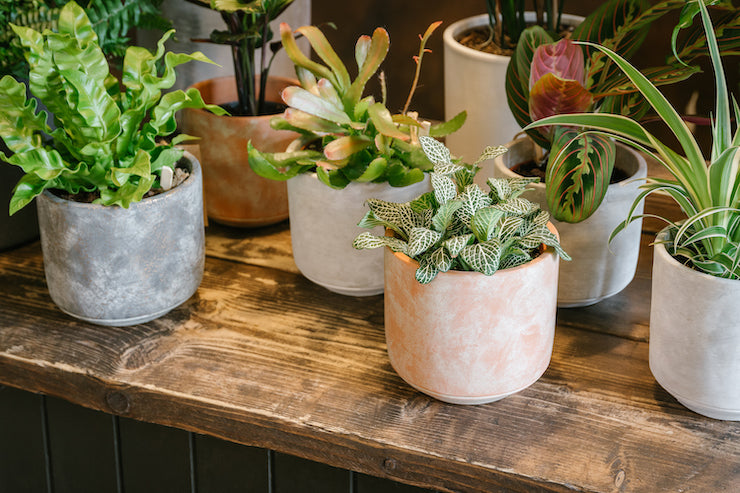
Ultimate Guide to Caring for Ficus Plants: Tips for Healthy Growth in UK Homes
There are over 800 members of the Ficus genus, most recognisable of which are commonly referred to as the Fiddle Leaf Fig and Rubber Plant, favoured for their large, glossy leaves and relatively low maintenance nature. These plants belong to the Moraceae family and are native to Asia, the Americas, Australia, and even Africa. This genus is incredibly adaptable, thriving in tropical, subtropical, and temperate regions. Ficus can flower all year, but they often flower seasonally in spring and summer. Unlike most plant varieties, Ficus produce inverted flowers hidden inside their fruits. The plant relies on fig wasps to enter the fruit and pollinate the flowers, enabling them to produce figs. While many species of this genus produce fruits, only a handful are suitable for human consumption.
There are many fascinating facts about this genus, including the Ficus elastica gaining its common name ‘Rubber Plant’ as its sap was traditionally harvested to produce rubber. With so many incredible varieties to choose from, why not add a member of this wonderful genus to your plant collection?
Caring for Ficus in UK Homes
Ficus thrive in bright, indirect light. This means the plant should be placed in a bright spot at least a metre away from a south-facing window, as the harsh midday sun can become magnified through the glass and scorch the leaves. Ficus should also be positioned away from particularly cold spots, such as draughty windows or doorways. Their watering requirements differ slightly from general houseplant care, as these plants prefer to have at least half of their compost dry out between waterings. The length of time between waterings will vary depending on changing temperatures throughout the year, so always check the compost is sufficiently dry before adding water by sticking your finger into the soil. If the plant is ready for a drink, remove it from any decorative pots without drainage, and pour water into the compost until it drains out of the holes at the base of its plastic pot. Once fully drained, place the plant back into its decorative pot.
Ficus are native to humid environments and require misting with water from a spray bottle a couple of times a week. Avoid misting in the evening, as water left sitting on the leaves overnight could cause the plant to become cold. Furthermore, position them away from dry heat sources, such as radiators or fireplaces, to prevent the leaves from becoming crispy.
Spring and summer are the growing seasons. This is when plants emerge from winter dormancy and begin producing new growth. During this period, plants use up nutrients in their compost, so it’s important to feed them at this time of year. We recommend Liquid Gold Leaf as the top feed option for Ficus. For best results, dilute 2ml in 1L of water every 2 to 4 weeks. Alternatively, for a simpler feed, Houseplant Focus can be diluted at 1 tsp to 1L of water once a month. As plants go into dormancy in autumn and winter, they don’t require extra nutrients and should not be fed until the following spring.
Ficus are generally quite fast-growing and usually need repotting once a year in spring or summer when the weather is warmer. You can tell when your Ficus needs repotting by checking if the roots are growing out of the drainage holes at the base of the pot. Alternatively, gently remove the plastic pot and check if the roots are densely spiralling at the base of the compost. If so, they’ve run out of space, and it’s time to size up the pot! These plants need slightly more drainage than general houseplants, so for best results, we recommend combining 60% base mix, 20% bark, and 20% sand. For a more budget-friendly option, you can mix 80% 3L Houseplant Focus with 20% Bettergrow Perlite. When repotting, always choose a pot with drainage holes, such as a plastic growing pot, and opt for one about 5cm larger in diameter to allow more space for root growth.
Tips and Tricks for Ficus
Leaf Drop
Leaf drop is usually a sign of stress and can be caused by several factors, including insufficient light, sudden changes in temperature, and underwatering. Ficus prefer to be placed in bright, indirect light. In a north-facing room, unless you have large windows, this will likely be closer to the window and out of any particularly shady corners. Sudden colder changes in temperature, draughty windows, and doorways can also lead to leaf drop, so reposition the plant to a slightly more sheltered spot. Underwatering is another common cause of leaf drop, often accompanied by dry, brown leaves.
If you have recently moved, it’s quite common for Ficus to drop leaves as they settle into their new home. This should settle with time.
Yellowing Leaves
Yellowing leaves are typically caused by overwatering. If this happens, make sure to check that the compost is sufficiently dry between waterings. Always remove the plant from decorative pots without drainage to avoid the roots sitting in excess water. Consider moving the plant to a slightly warmer spot. It’s also worth checking the compost quality. If it’s overly compact and slow to drain, you may want to switch to a Ficus-appropriate compost, which can be found in the care section of this blog.
Brown Patches
Dry brown patches usually form from too much direct light, infrequent watering, or being too close to a heat source. If you notice dry, brown patches, this is likely due to too much direct light, so move your plant to a bright spot without direct sunlight hitting the leaves. Crispy edges and leaf tips suggest the plant isn’t receiving enough humidity, so increase misting throughout the week. Also, move the plant away from dry heat sources like radiators or fireplaces to prevent the leaves from drying out too quickly. Over-fertilising can also cause leaves to turn brown, so make sure your feeding schedule is appropriate for this genus.



